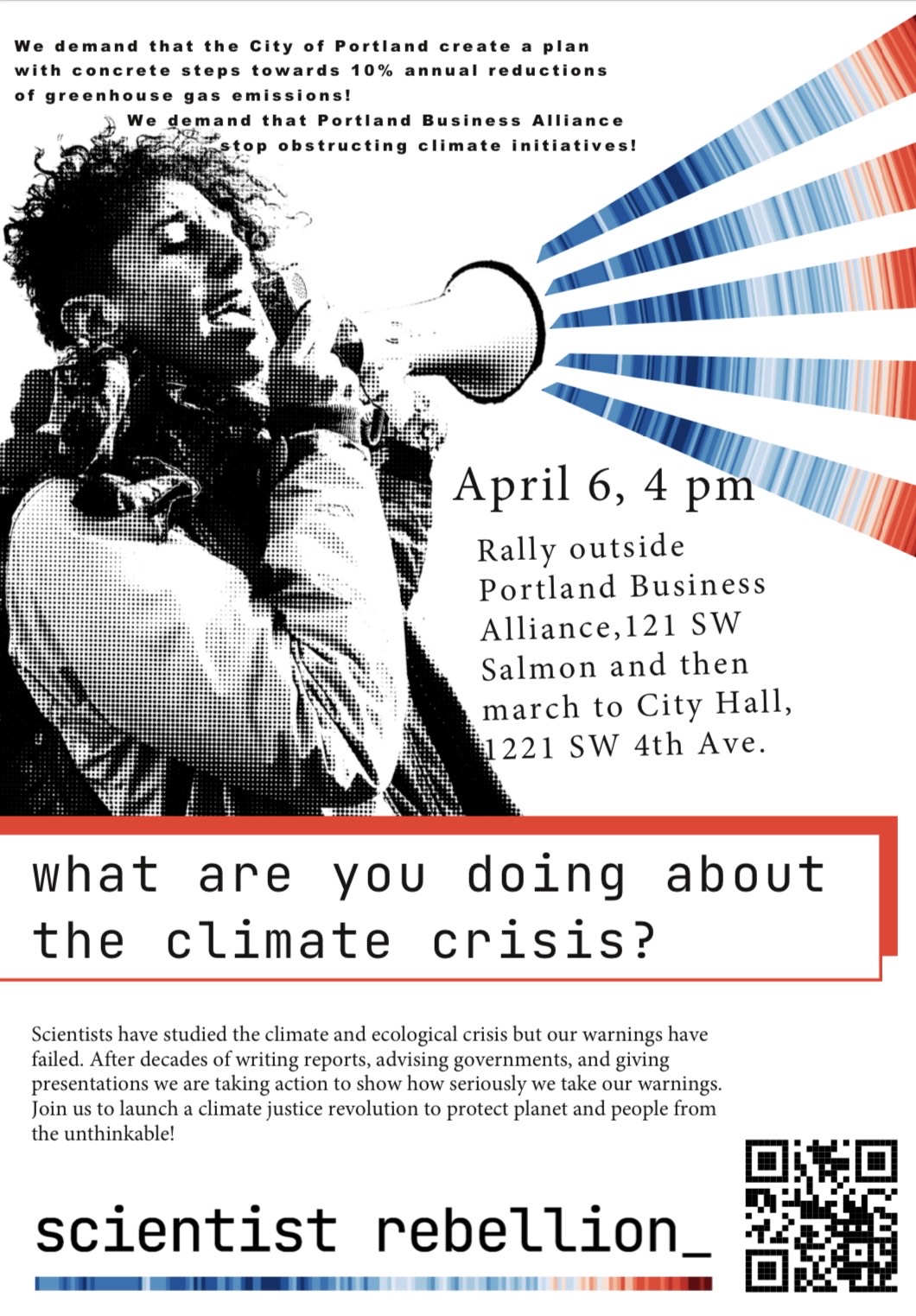“I’m here because scientists are not being listened to.” – Dr. Peter Kalmus
April 6, 2022, Los Angeles, California
A man in a white lab coat, chained to the door of fossil-fuel-funder Chase Bank, was pleading and weeping as a livestreamer captured his anguish for social media: “… we’re heading toward a fucking catastrophe… we’re going to lose everything! And we’re not joking. We’re not lying. We’re not exaggerating. This is SO BAD, everyone, that we are willing to take this risk. And more and more scientists, and more and more people, are going to join us.” A phalanx of over 100 LAPD officers took over the street, marching to arrest NASA climate scientist Peter Kalmus and 3 colleagues.
April 6, 2022, Portland, Oregon
Two scientists in white lab coats, astronomer Bernadette Rodgers of Willamette University and PhD candidate in materials science William Livernois of University of Washington, sat in the lobby of the Portland Business Alliance (PBA) while police approached, plastic handcuffs at the ready. Nearby, dozens of XRPDX rebels and allies sang and witnessed in support. The courageous, peaceful direct action was the culmination of a march and rally to draw attention to the inaction on climate by the city government and the attempted obstruction of Portland Clean Energy Fund by PBA. Photographer Olivia Louise, in a photo shared hundreds of times on Twitter, captured the eerie moment as William, flanked by two cops, was perp-walked out of the building.
Scientist Rebellion was founded in 2020 when two physicists threw paint over the Royal Society in London, and called on scientists to engage in nonviolent civil disobedience to raise the alarm. Scientists know the present impacts and projected devastation of the climate crisis, and they also know, or are working to discover, what humanity can do to avert the worst of their predictions.
The ice cores they’ve collected tell them. The computer models they create and revise tell them. The counts of billions of creatures, boiled alive in overheated coastal waters or burned in vast wildfires, tell them. The daily CO2 measurements at Mauna Loa, Hawai’i tell them. The data they gather for the IPCC Reports tell them. Their colleagues, in calm professional presentations at conferences, and in less calm, informal conversations over beer, tell them. They tell each other.
And then they tell…everyone they can reach, from the United States Congress and the United Nations to high school kids at rallies. They told us. They keep telling us.
It has not worked. Part of the reason for that failure is how scientists commonly communicate: with more tentative, technical and restrained language, their conclusions presented in terms of probability rather than certainty, making it harder for non-scientists to understand and easier to shrug off. Also, corporate-funded denial campaigns, and threats and hate speech against scientists, have done the dirty work of intimidation and delay.
But besides all that, otherwise rational decision-makers and the public are paralyzed by a strange sort of denial known as “implicatory.” In States of Denial: Knowing about Atrocities and Suffering, author Stanley Cohen explains that in this form of denial, the facts and seriousness of the situation are known, but not acted upon; the urge to act is suppressed by various cognitive tricks. Against this sort of denial, scientists’ findings and testimonies have made little real progress. “We” – that is, most institutions and persons – have given lip service or turned away; we have not really listened.
But what has been denied and is still downplayed or silenced can no longer be completely ignored. Scientists speak softly; reality roars. Climate modeling predictions are in some cases being overtaken by events, like last June’s killer heat dome in the Pacific Northwest and the current weeks-long, extraordinary, crop-destroying heat waves in India and Pakistan.
On the Scientist Rebellion website, scientists challenge their peers: “What is the point in documenting in ever greater detail the catastrophe we face, if we are not willing to do anything about it?” Indeed. As a non-scientist, I would urge everyone who is a scientist, of whatever branch of science, to focus your trained mind on the question that follows from the previous one. Scientists’ communications methods have been unsuccessful in effecting the changes that your research shows the need for – why not try collective direct action?
April 6, the international day of action when scientists in 25 countries risked — and were! — arrested for nonviolent resistance to the frozen status quo, may turn out to be, to use Professor Tim Lenton’s metaphor, “the positive tipping point to avoid climate tipping points.” There’s one way to find out, scientists: take action. And then tell others and demand media and public attention, as Bernadette and William did here.
Satirized (fondly or otherwise) though they are, scientists have credibility on the climate crisis like no other occupational group. A massive uptick in the number of scientist- activists would — I hope, will! — turbo-charge the climate justice movement. In addition to depth of knowledge, some of them have wicked-brilliant senses of humor: https://www.theatlantic.com/science/archive/2018/11/satire-teaching-science-climate-change/574645/
I could use a scientifically-informed laugh right now, an astringent chaser to my daily dose of climate despair.


1 thought on “The Day Scientists Got Arrested”
Comments are closed.